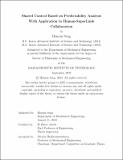| dc.contributor.advisor | Asada, H. Harry | |
| dc.contributor.author | Song, Hanjun | |
| dc.date.accessioned | 2023-11-02T20:06:00Z | |
| dc.date.available | 2023-11-02T20:06:00Z | |
| dc.date.issued | 2023-09 | |
| dc.date.submitted | 2023-09-28T15:51:26.136Z | |
| dc.identifier.uri | https://hdl.handle.net/1721.1/152652 | |
| dc.description.abstract | This thesis presents data-driven quantitative methodologies based on predictability analysis to construct shared control in human-robot collaborations. The methods are applied to assist hemiplegic patients in a bimanual eating task (i.e., eating with a fork and a knife) with a Supernumerary Robotic Limb, or SuperLimb for short. The core idea of the study is to assign situations with high predictability to the robot’s autonomy and situations with low predictability to the human’s intervention or manual control. Furthermore, we find a method to improve predictability by seeking useful information that robots are not able to observe.
The first phase of the study utilized correlation data analysis and principal component analysis (PCA) to measure the predictability of hand movements during the bimanual task. Correlation data analysis reveals that a few degrees of freedom (DOF) of the hand holding the knife are not significantly correlated with any other DOF, indicating independent, voluntary movements that are difficult to predict. On the other hand, a few DOF are strongly correlated with the fork movements and therefore predictable. Based on the analysis, a hybrid SuperLimb is designed so that the independent DOF are powered and manually controlled by human body movements, while the predictable DOF are automatically controlled by robot actuators.
In the second phase of the study, Extended Lipschitz Analysis (ELA) is developed as another method of measuring predictability. ELA evaluates the demonstration data by computing Lipschitz quotients and informs the level of predictability of the desired action independent of the prediction model. The Lipschitz quotients tend to be very high in some situations due to the information discrepancy between humans and robots and lower when humans and robots share information. Therefore, ELA provides a method of lowering Lipschitz quotients by seeking missing information and adding a new variable to the input space. Unpredictable situations where the Lipschitz quotients are high even after the new variable is added are assigned to the human and the remaining situations with small Lipschitz quotients are assigned to the robot. | |
| dc.publisher | Massachusetts Institute of Technology | |
| dc.rights | In Copyright - Educational Use Permitted | |
| dc.rights | Copyright retained by author(s) | |
| dc.rights.uri | https://rightsstatements.org/page/InC-EDU/1.0/ | |
| dc.title | Shared Control Based on Predictability Analysis With Application to Human-SuperLimb Collaboration | |
| dc.type | Thesis | |
| dc.description.degree | Ph.D. | |
| dc.contributor.department | Massachusetts Institute of Technology. Department of Mechanical Engineering | |
| mit.thesis.degree | Doctoral | |
| thesis.degree.name | Doctor of Philosophy | |
